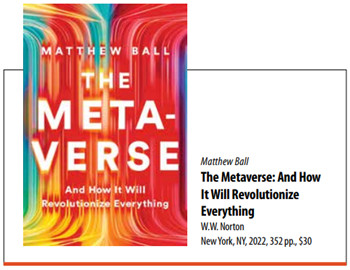Despite its forward-looking title, The Metaverse: And How It Will Revolutionize Everything is as much about the past as it is about the future.
Based on a series of blog posts by author Matthew Ball, this book intersperses anecdotes from the pre-Internet era with comprehensive current evidence to convince the reader that a scalable, interoperable metaverse is coming, and that it will be transformative.
The essence of the book is the definition of the metaverse, broken down and explained, concept by concept. Ball, an expert on the topic, uses simple analogies to condense difficult concepts about networking, computing, virtual world engines (game engines), interoperability, hardware, payment rails, and blockchain. He also brings the reader along to investigate the role of Web3 and NFTs (non-fungible tokens) in the metaverse evolution, which, according to the author, is mired in technical, legal, and cultural barriers.
The author continuously reinforces the idea that “uncertainty and confusion are the features of disruption.” Diving into the history of the personal computer, the internet, cable, mobile phones, streaming, gaming, and virtual and augmented reality, he posits that the metaverse is real, and it is imminent.
The most intriguing part of the book is the economics of the gaming industry, which Ball initially categorizes as a “$180 billion leisure industry.” He goes on to explain that it is “poised to alter the $95 trillion world economy” by showing how it makes economic sense for virtual worlds to share data and interoperate. And with some 75 percent of American children now playing on a single gaming platform, and 140 million potential gamers born each year, society itself is transforming the metaverse. What is noteworthy here are Ball’s proclamations about the duopoly in the smartphone industry, which constrains the margins of virtual world platforms and impedes their interoperability and integration. This hinders the development of metaverse-focused technologies, and he calls for regulatory action to loosen the grip of Google and Apple on payment systems and app stores.
Ball demystifies the narrative on the metaverse by clarifying how it will be browser based and accessible (for example, through gaming consoles, PCs, and smartphones) and thus provide “an individual sense of presence” (that is, your very own digital twin alias/avatar) without a VR headset. Still, many critics would argue that an introduction to a functioning metaverse would add value to the book.
Building on his work in angel investing, corporate venture advising, television and film production, and video gaming—and warning that “technology frequently produces surprises that no one predicts”—the author calls for governance and standards for the metaverse, akin to the evolution of the internet, which functions thanks to common protocols around visual presentation, file loading, graphics, and data.
We all may be understandably wary when it comes to the idea of the intrusion of the metaverse into our lives, but this book reinforces my belief in the need to seize the untouched opportunity of work on regulations and standards for this parallel virtual economy, sooner rather than later.
Opinions expressed in articles and other materials are those of the authors; they do not necessarily reflect IMF policy.










